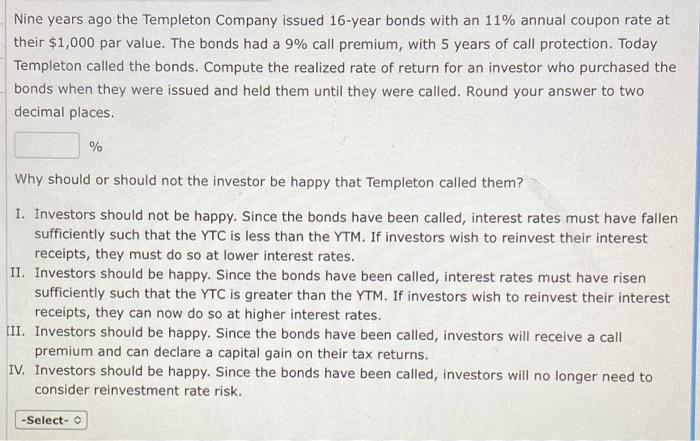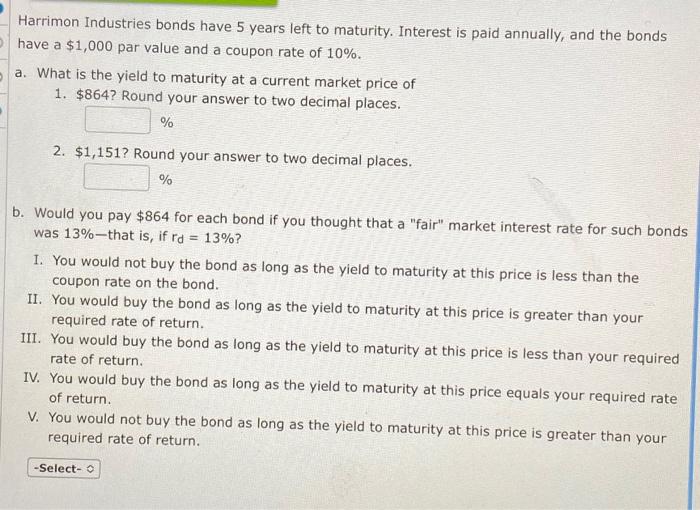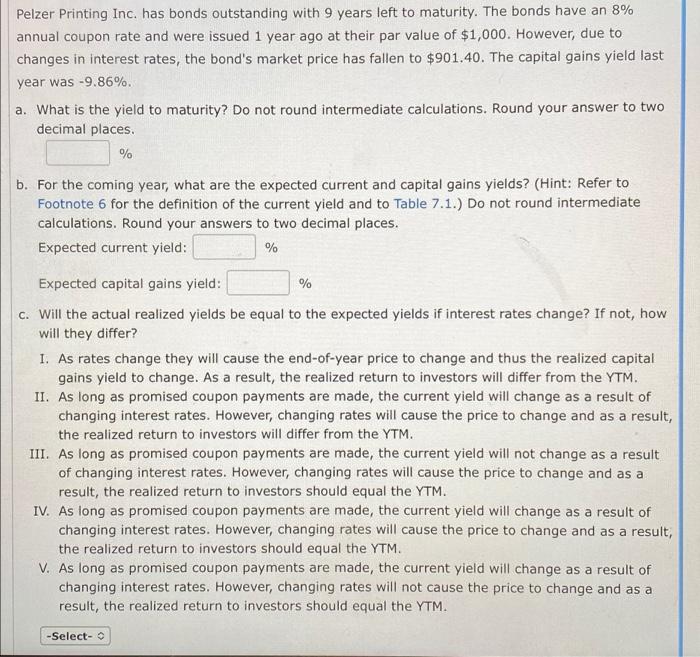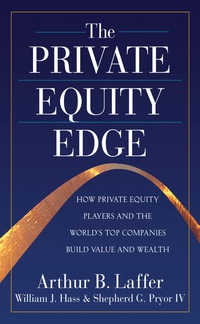Nine years ago the Templeton Company issued 16-year bonds with an 11% annual coupon rate at their $1,000 par value. The bonds had a 9% call premium, with 5 years of call protection. Today Templeton called the bonds. Compute the realized rate of return for an investor who purchased the bonds when they were issued and held them until they were called. Round your answer to two decimal places. % Why should or should not the investor be happy that Templeton called them? I. Investors should not be happy. Since the bonds have been called, interest rates must have fallen sufficiently such that the YTC is less than the YTM. If investors wish to reinvest their interest receipts, they must do so at lower interest rates. II. Investors should be happy. Since the bonds have been called, interest rates must have risen sufficiently such that the YTC is greater than the YTM. If investors wish to reinvest their interest receipts, they can now do so at higher interest rates. (II. Investors should be happy. Since the bonds have been called, investors will receive a call premium and can declare a capital gain on their tax returns. IV. Investors should be happy. Since the bonds have been called, investors will no longer need to consider reinvestment rate risk. -Select- Madsen Motors's bonds have 25 years remaining to maturity. Interest is paid annually, they have a $1,000 par value, the coupon interest rate is 10%, and the yield to maturity is 12%. What is the bond's current market price? Round your answer to the nearest cent. $ Harrimon Industries bonds have 5 years left to maturity. Interest is paid annually, and the bonds have a $1,000 par value and a coupon rate of 10%. a. What is the yield to maturity at a current market price of 1. $8642 Round your answer to two decimal places. % 2. $1,151? Round your answer to two decimal places. % b. Would you pay $864 for each bond if you thought that a "fair" market interest rate for such bonds was 13%-that is, if ra = 13%? 1. You would not buy the bond as long as the yield to maturity at this price is less than the coupon rate on the bond. II. You would buy the bond as long as the yield to maturity at this price is greater than your required rate of return. III. You would buy the bond as long as the yield to maturity at this price is less than your required rate of return. IV. You would buy the bond as long as the yield to maturity at this price equals your required rate of return. V. You would not buy the bond as long as the yield to maturity at this price is greater than your required rate of return. -Select- Nesmith Corporation's outstanding bonds have a $1,000 par value, a 12% semiannual coupon, 11 years to maturity, and a 15% YTM. What is the bond's price? Round your answer to the nearest cent. $ Pelzer Printing Inc. has bonds outstanding with 9 years left to maturity. The bonds have an 8% annual coupon rate and were issued 1 year ago at their par value of $1,000. However, due to changes in interest rates, the bond's market price has fallen to $901.40. The capital gains yield last year was -9.86%. a. What is the yield to maturity? Do not round intermediate calculations. Round your answer to two decimal places % b. For the coming year, what are the expected current and capital gains yields? (Hint: Refer to Footnote 6 for the definition of the current yield and to Table 7.1.) Do not round intermediate calculations. Round your answers to two decimal places. Expected current yield: % Expected capital gains yield: % c. Will the actual realized yields be equal to the expected yields if interest rates change? If not, how will they differ? 1. As rates change they will cause the end-of-year price to change and thus the realized capital gains yield to change. As a result, the realized return to investors will differ from the YTM. II. As long as promised coupon payments are made, the current yield will change as a result of changing interest rates. However, changing rates will cause the price to change and as a result, the realized return to investors will differ from the YTM. III. As long as promised coupon payments are made, the current yield will not change as a result of changing interest rates. However, changing rates will cause the price to change and as a result, the realized return to investors should equal the YTM. IV. As long as promised coupon payments are made, the current yield will change as a result of changing interest rates. However, changing rates will cause the price to change and as a result, the realized return to investors should equal the YTM V. As long as promised coupon payments are made, the current yield will change as a result of changing interest rates. However, changing rates will not cause the price to change and as a result, the realized return to investors should equal the YTM. -Select











